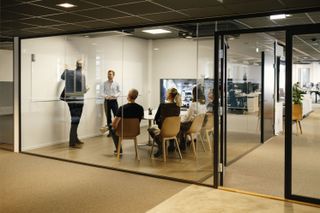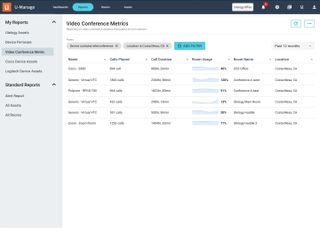Data-driven AV is nothing new. For the past five years, AV endpoints have been migrating to the network with the promise of capturing room metrics and system analytics. The cloud, 5G’s lightning-fast connectivity, IoT sensors, and artificial intelligence (AI) are converging to capture more valuable data in more locations. Some AV professionals believe this confluence will usher in a new era of design, one in which systems are built with learned user behaviors in mind.
AI in Focus
AI is already making an impact in higher education. Machine learning solutions are crunching vast dataset stacks to help stakeholders retain and support students. Schools like Penn State University are blazing ahead with AI development, centering the emerging technology as an essential pedagogical tool. Penn State’s Nittany AI Alliance tasks students to innovate with AI and solve “real-world problems.”
The corporate campus is also feeling the AI push as decision-makers strive to improve data visualization and share resources more effectively. Governments and enterprises are leveraging facial detection and recognition to enhance guest experiences and user safety. AI can also output user patterns that were once invisible (or at least hard to track), revealing new opportunities for training. But how far into the future is pro AV’s “AI moment”? Which AV applications are best suited for AI at scale? Behemoths like Google and Qualcomm are investing heavily in AI, but how much longer until every booth at InfoComm sports a “powered by AI” poster?
Where AI and Pro AV Intersect
Managed services and support contracts have been steady offerings for many AV integrators, but AI promises to lead the category into interesting directions. Even with AV over IP systems in place, if a fix or upgrade cannot be delivered remotely, vendors still need to travel to a job site to troubleshoot. With the predictive analytical power of AI, a vendor may be able to turn a “traditional” system into a proactive one. Such a design, hypothetically, can push a maintenance alert days or weeks before a problem arises, giving integrators more control and flexibility.
“We look at the data collected around the equipment itself, failure rates, time to reset, usage data, and combine that with user data, and we expect that AI will be able to eliminate the Tier 1 Help Desk,” said Frank Pellkofer, co-founder and president of Utelogy, the California-based manufacturer of software-defined AV solutions. “Let’s assume the AI engine has been able to determine that there’s a 72 percent chance that the projector alert can be resolved with a reboot. The system could then assess whether or not there are people in the room, and if not, if anyone is scheduled to come into the room. If there is a meeting in 10 minutes, but the system knows that this device has a three-minute reboot process, the system automatically reboots without any human interaction. We believe that self-healing is a key benefit surrounding AI. We’re doing some of that today, but we expect it to have a greater impact in the future.”
UCC, Active Directories, and Personalization
Mario DiAntonio, director of sales for B2B technical account management and EBC programs at Samsung Electronics America, says the integration of voice and intelligent assistants offers countless opportunities in the professional AV space. One such opportunity is pairing this technology with a smart Active Directory.
“Companies already have a database of their employees’ contact and business information,” DiAntonio said. “With a smart AD, enterprises can begin storing biometric data as well, including voice. We could completely eliminate the need to log in to flexible meeting spaces. Instead, employees could walk into a conference room and their preferences would be automatically enabled by voice recognition.”

Pexip, a manufacturer of UCC solutions, is dedicated to making scheduling, joining, and conducting a meeting easier so users can focus on the meeting itself. Therefore, the team is dedicated to building an infrastructure “that can elastically scale up during peak periods, allowing calls to always connect without having to manage or pay for a massive infrastructure environment,” said Jordan Owens, vice president of architecture at Pexip. The company also wants to empower the user and save them time by allowing them to seamlessly join a meeting “from the right device at the right time.”
AI is an essential element of Pexip’s roadmap, leveraged “from the outset of the company’s offering.”
Actionable Intelligence
Pellkofer explained that much of Utelogy’s recent success has to do with the company’s U-Manage platform and its ability to deliver management and monitoring data. Utelogy’s clients are looking to use that data to provide artificial intelligence, as well as actionable intelligence, to drive future designs and installations. That data capture, through the use of machine learning and artificial intelligence, should inform better design and integration choices.

He shared an example: “From historical data, we know that the rooms on the eighth floor are never used on Fridays, so we’ll use this intelligence in the system to guide people to use rooms on other floors. We can power down that floor. The digital signage and wayfinding systems can guide people to the best meeting rooms on other floors.”
AI Will Make UX More Transparent
For Owens, concepts such as AI and predictive analytics within the AV realm are “all about simplification versus polish and elegance.”
AI’s value for AV pivots around a few key questions: “How do we make the user’s experience more transparent and simple? How do we make the technology disappear into the background? How do we give the users the right choices without compromising flexibility? This is only possible if we customize and present the right experience to the right user at the right time,” said Owens. “It’s also only meaningful if we can give users more options to connect without exposing the complexity to them or their administrators.”
AI + AV Will Spur an Organization’s Digital Transformation
According to Pellkofer, an ecosystem of interoperability—including cloud-based AV and other technologies that play nicely in the cloud—will emerge. Utelogy, as a platform, connects sensor data to room bookings. As the system gathers more data and becomes smarter, it can provide more useful insights for workplace designers.
Pellkofer believes that AI will extend beyond the meeting itself “as sensors are used to measure participant engagement, tagging and indexing of content, and predicting optimal technology and optimal space design. This is where it becomes part of an organization’s digital transformation.”
As AI collects more data, and exports that data directly into analysis tools, teams can focus on work requiring human talent and expertise, leaving repetitive processes to the machines.
AI Removes Administrative Complexity
AI may also help address connectivity challenges and offer personalized user support. Through Pexip features such as cloud bursting (which facilitates dynamic bursting to a cloud service) and automatic load balancing (automatically utilizing the right resources at the right time), “we have removed administrative complexity that has prevented customers from scaling their videoconferencing footprint to thousands of end users,” Owens said.
The Road Ahead for AI & AV
Utelogy’s goal is to “become more relevant in the workplace.” One of the key ways to deliver workplace value is by consolidating data into a centralized platform. “Then we can take that data to deliver further artificial intelligence and predictive analytics about the economy of people,” said Pellkofer.
Samsung is demonstrating its AI commitment, investing heavily in its SmartThings smart home automation system by growing its ecosystem as well as its ability to serve customers. SmartThings products can connect with intelligent assistants like Bixby, Google Home, and Alexa—further connecting commercial and residential applications.
“At Samsung, we develop technology and solutions that benefit our entire product ecosystem. We leverage our AI-upscaling technology in the 8K QLED commercial displays as well as consumer TVs, and our Tizen operating system is ubiquitous among our enterprise and consumer products,” said DiAntonio. “Samsung is constantly looking for solutions to help our customers accomplish what they didn’t think was possible, and we believe wholeheartedly that AI is at the forefront.”













